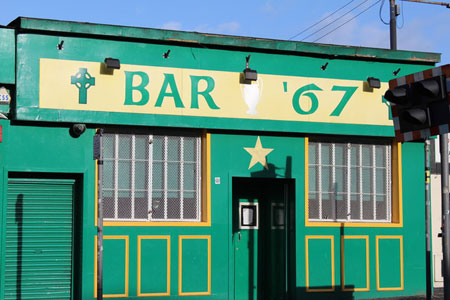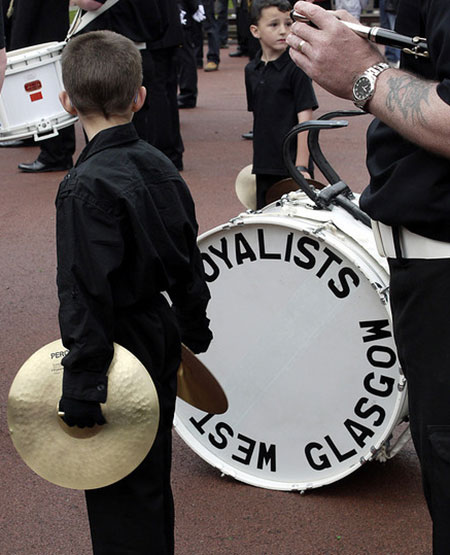Blog
Occasional posts on subjects including field recording, London history and literature, other websites worth looking at, articles in the press, and news of sound-related events.
The sounds of sectarianism
THE DOOR TO Norma Jean’s bar flew open with a bang and a naked man ran out onto the Gallowgate. He gibbered something we couldn’t catch and then sped round the corner of McFarlane Street and was gone.
Big John, Young John, the Patterson brothers and myself had finished work later than planned in Glasgow’s Barras market and we’d decided to go for a drink. It was Big John’s idea that we visit Norma Jean’s, which had a lively reputation.
We ignored the omen of the naked man and made for the bar’s battered-looking door. Norma Jean’s was one of those places that was impossible to see into from the street. Anything could be waiting behind the door. The inside of the bar turned out to be dark and raucous with laughter.
Within seconds hands began reaching towards us, grabbing at our clothes. “What’s the score here? We’re no wanting trouble,” Big John shouted. A wiry-looking man with a scarred face grinned at him. “Aye but we do. Youse look like bluenoses and this is what we do to bluenoses.” He raised his voice: “Take their clothes off and get them to fuck!”
We all backed out quick before Norma Jean’s denizens could get a better hold on us. A fresh wave of laughter followed us into the street before the door slammed shut again. Right enough they had got us to fuck, meaning driven us away, but fortunately not like the naked man. Bluenoses were Rangers fans, and the bar was in the heart of the Calton district, notable for having Scotland’s lowest male life expectancy at just 54 years and being solid territory for Celtic supporters.
This was in the late 1980s. Norma Jean’s has changed hands and names a few times since then but, as you can see from Leslie Barrie’s Creative Commons-licensed photo on Geograph, it still makes its allegiances pretty clear as Bar ‘67:

Celtic are for Catholics and Rangers are for Protestants and anyone wanting to sidestep that division might develop an interest in Partick Thistle, but they’d slipped out of the top tier of Scottish football in 1982. When the Old Firm teams played each other, or the Orange Walk approached each 12th of July, sectarian feelings found their traditional rhythms.
Flute bands began practicing in halls and the backs of bars. The pulse of lambeg drums stopped and started from unseen places, once accompanying the sight of a gorse fire creeping up the slopes of the Nitshill housing scheme at dusk. Boys stamped the beat of The Sash on the top decks of buses and drunk men hollered the Irish national anthem. Business picked up for those stalls in the Barras which pragmatically sold cassette tapes appealing to both sides. One half of a stock display would feature the Easterhouse Truth Defenders and the Silver Skull Flute Band and the other half the Wolfe Tones and compilations of Irish rebel songs.

As a young Londoner I was able to meet and observe both sides without much problem, Glaswegians being generally friendly people who viewed the English as irreligious and hence uncommitted to either side. In 1990 I moved to Edinburgh to find work in the printing industry and ended up in a firm run by fanatical Rangers supporters. The Celtic–Rangers division was mirrored in Edinburgh by the city teams of Heart of Midlothian and Hibernian, but the printers weren’t much interested in them.
The workplace ghetto blaster had a stack of flute band tapes next to it and, each Friday, these provided the music for an improvised Orange Walk that threaded its way round the presses and developing tanks. Wastepaper bins given gaffer-tape straps and steel compositors’ rulers held up to the mouth mimed the duties of drum and flute.
The rancour and boredom behind the Friday parade and the endless singing of No Pope of Rome quickly grew tiresome and it was good to leave that job.
All that was part of what I remember of the soundscapes of those times and places. Not a big part, but in there among the newspaper sellers in Hope Street and the soapbox orators in Argyle Street, the hen parties banging their pots and pans and the boys selling candy apples round the housing schemes – most likely on the way out now.
ABOUT SOUND
FIELD RECORDINGS
The balloonist in the desert is dreaming
The Binaural Diaries of Ollie Hall
GEOGRAPHY AND WANDERINGS
The Ragged Society of Antiquarian Ramblers
LONDON
ORGANISATIONS
Midwest Society for Acoustic Ecology
World Forum for Acoustic Ecology